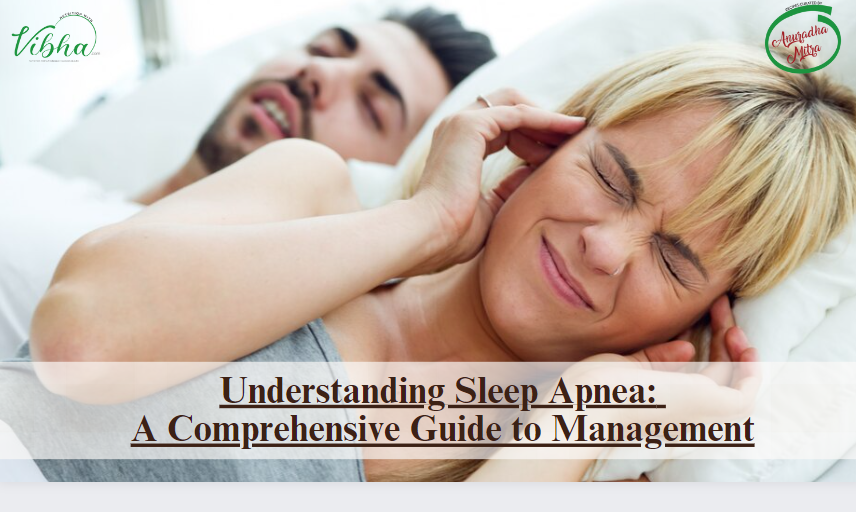Understanding Sleep Apnea: A Comprehensive Guide to Management!

Sleep apnea is a prevalent yet often underestimated sleep disorder that affects millions of people worldwide. Characterized by interruptions in breathing during sleep, this condition can have serious consequences for one’s health and overall well-being. In this blog, we will delve into the intricacies of sleep apnea, exploring its types, symptoms, and most importantly, effective management strategies.
What is Sleep Apnea?
Sleep apnea is a disorder where an individual experiences pauses in breathing or shallow breaths while asleep. The most common type is obstructive sleep apnea (OSA), which occurs when the muscles in the throat relax excessively, leading to a blockage in the airway. Another less common form is central sleep apnea (CSA), where the brain fails to send proper signals to the muscles controlling breathing.
Recognizing the Symptoms
It’s crucial to recognize the symptoms of sleep apnea early on to initiate proper management. Common signs include loud snoring, gasping for air during sleep, restless tossing and turning, excessive daytime sleepiness, morning headaches, and difficulty concentrating. If you or a loved one exhibits these symptoms, it’s essential to consult a healthcare professional for a proper diagnosis.
Why is Sleep Apnea of concern?
Sleep apnea, if left untreated, can have profound consequences on both physical and mental health. The interrupted breathing patterns during sleep lead to a range of issues that extend beyond mere fatigue, impacting various aspects of daily life.
1. Cardiovascular Complications
One of the most significant consequences of untreated sleep apnea is its link to cardiovascular problems. The repetitive pauses in breathing cause oxygen levels to drop, triggering the release of stress hormones. This, in turn, raises blood pressure and puts extra strain on the heart. Over time, this can contribute to the development of hypertension, increasing the risk of heart disease, stroke, and other cardiovascular issues.2.
2. Daytime Fatigue and Impaired Cognitive Function
Continuous disruptions in sleep prevent individuals with sleep apnea from reaching the crucial deep stages of sleep. As a result, they wake up feeling fatigued and may experience excessive daytime sleepiness. This chronic exhaustion impairs cognitive function, leading to difficulties with concentration, memory, and overall mental sharpness. This can significantly impact work performance, academic success, and the ability to engage in daily activities.
3. Mood Disturbances
Sleep apnea has been associated with mood disturbances such as irritability, anxiety, and depression. The lack of restorative sleep affects neurotransmitter levels, contributing to changes in mood and emotional well-being. Individuals with untreated sleep apnea may find themselves more prone to mood swings and a generally diminished quality of life.
4. Increased Risk of Accidents
Daytime sleepiness resulting from sleep apnea poses a risk not only to the affected individual but also to those around them. The impaired alertness and slower reaction times increase the likelihood of accidents, both on the road and in other daily activities. This heightened risk underscores the importance of addressing sleep apnea promptly to ensure the safety of oneself and others.
5. Compromised Metabolic Health
Sleep apnea has been linked to metabolic disturbances, including insulin resistance and an increased risk of type 2 diabetes. The hormonal imbalances caused by sleep apnea can interfere with the body’s ability to regulate blood sugar levels, contributing to the development or exacerbation of diabetes.
In conclusion, the consequences of untreated sleep apnea extend far beyond disrupted sleep. From cardiovascular complications to impaired cognitive function and increased accident risk, the impact on overall health and well-being is substantial. Recognizing the symptoms and seeking timely intervention are crucial steps in mitigating these consequences and improving both the quantity and quality of sleep.
Diagnosis and Evaluation
Diagnosing sleep apnea typically involves a sleep study, also known as polysomnography. During this overnight test, various parameters such as brain activity, eye movement, heart rate, respiratory effort, air flow, and blood oxygen levels are monitored. Home sleep apnea tests are also available in some cases, offering a more convenient option for certain individuals.
Dietary Habits for:
1. Managing Sleep Apnea:
Diet plays a pivotal role in managing sleep apnea, offering a complementary approach to traditional treatments. A strategic dietary plan can help alleviate symptoms and improve overall sleep quality for individuals dealing with this sleep disorder.
2. Weight Management:
Maintaining a healthy weight is key, as excess weight contributes to the narrowing of the airways, exacerbating obstructive sleep apnea. Incorporating a balanced diet with a focus on whole foods, lean proteins, fruits, and vegetables can support weight loss efforts.
3. Fluid Intake:
Limiting alcohol and sedative intake, especially close to bedtime, is essential. These substances relax the muscles in the throat, increasing the likelihood of airway obstruction. Additionally, reducing caffeine intake in the afternoon and evening can promote better sleep.
4. Anti-Inflammatory Foods:
Including anti-inflammatory foods, such as fatty fish, nuts, and leafy greens, may help mitigate inflammation that can contribute to sleep apnea. Omega-3 fatty acids found in fish like salmon possess anti-inflammatory properties beneficial for respiratory health.
Positional Dietary Strategies:
Consuming smaller meals and avoiding heavy, rich foods closer to bedtime may reduce the likelihood of acid reflux, a common contributor to sleep disturbances.
By embracing a diet focused on weight management, inflammation reduction, and mindful substance intake, individuals with sleep apnea can enhance their overall well-being and potentially experience improvements in their sleep patterns. As always, consulting with a healthcare professional for personalized dietary recommendations is advisable.
Lifestyle Changes for Managing Sleep Apnea:
1. Exercise Therapy:
While aerobic and anaerobic exercises go a long way in weight reduction and improving sleep, incorporating targeted exercises into your routine can be a proactive and effective way to reduce the severity of sleep apnea symptoms.
While these exercises may not be a cure, they can contribute to strengthening the muscles involved in breathing and promoting better airflow during sleep.
2. Tongue and Throat Exercises:
Tongue Slides:
Slide your tongue backward along the roof of your mouth as far as possible. Repeat several times daily to strengthen tongue muscles.
Throat Exercises:
Open your mouth and move your jaw to the left and right, holding each position for a few seconds. This helps tone the muscles in your throat.
Playing Wind Instruments:
Engaging in wind instrument practices, such as playing the didgeridoo or certain brass instruments, has been associated with improved muscle tone in the throat and a reduction in sleep apnea symptoms.
Singing Exercises:
Regular singing exercises, especially those that involve sustained vowel sounds, can help strengthen the muscles in the throat and improve muscle control.
Using Yoga postures that stretch the muscles of the face, neck and chest as well.as various breathing exercises like Pranayam and Kapalbhati will help reduce symptoms.
Facial yoga also helps in toning muscles of the jaw and neck that can aid reduce the severity of sleep apnea.
Incorporating these exercises into a daily routine, along with other lifestyle modifications, may contribute to a comprehensive approach in managing sleep apnea. However, it’s essential to consult with a healthcare professional before starting any exercise regimen to ensure that it is appropriate for your individual condition.
3. Sleep Position:
Sleeping on your back may worsen obstructive sleep apnea. Experiment with sleeping on your side to see if it reduces symptoms.
4. Avoiding Alcohol and Sedatives:
Alcohol and sedatives relax the muscles in the throat, potentially exacerbating sleep apnea. Limiting or avoiding these substances, especially close to bedtime, can be beneficial.
5. Establishing a Consistent Sleep Schedule:
Going to bed and waking up at the same time every day helps regulate your body’s internal clock, promoting better sleep quality.
Medical Therapy for Sleep Apnea:
1. Continuous Positive Airway Pressure (CPAP) Therapy
One of the most common and effective treatments for moderate to severe sleep apnea is CPAP therapy. This involves wearing a mask over the nose or mouth during sleep, which is connected to a machine delivering a continuous stream of air to keep the airway open. While some individuals find the CPAP apparatus initially uncomfortable, its benefits in improving sleep quality and reducing symptoms are well-documented.
2. Bi-level Positive Airway Pressure (BiPAP) Therapy
BiPAP is similar to CPAP but allows for different air pressure levels during inhalation and exhalation. This can be especially beneficial for individuals who find it challenging to exhale against the continuous pressure of a CPAP machine.
3. Adaptive Servo-Ventilation (ASV) Therapy
ASV is a more advanced form of positive airway pressure therapy that adjusts pressure levels based on the individual’s breathing patterns. It is often prescribed for central sleep apnea and complex sleep apnea syndrome.
4. Oral Appliances
For those with mild to moderate obstructive sleep apnea, oral appliances may be a viable option. These devices, resembling mouthguards, are designed to reposition the tongue and jaw to keep the airway open.
5. Surgery
Surgical options are typically considered when other treatments prove ineffective or are not well-tolerated. Surgical interventions may include uvulopalatopharyngoplasty (UPPP), genioglossus advancement (GA), or maxillomandibular advancement (MMA). Each surgery aims to address specific anatomical issues contributing to sleep apnea.
6. Positional Therapy
Positional therapy involves encouraging individuals to sleep in positions that minimize airway obstruction. Specialized devices or positional pillows can help maintain a side-sleeping position, reducing the severity of sleep apnea.
Regular Follow-ups and Monitoring
Regardless of the chosen management strategy, regular follow-up appointments with healthcare providers are crucial. Periodic assessments ensure that the chosen treatment remains effective, and adjustments can be made if necessary.
Sleep apnea is a serious condition that requires careful management to mitigate its impact on both physical and mental health. From lifestyle changes to advanced therapies, there are various approaches to address this sleep disorder. If you suspect you or someone you know may have sleep apnea, seeking professional medical advice is the first step toward better sleep and overall well-being. Remember, effective management not only improves sleep quality but also contributes to a healthier, more energized life.
We at nutritionwithvibha.com look forward to creating a sustained positive change in health. Sleep is a cornerstone of health, we heal during the cycles of sleep. Thus, if this important aspect of health is interrupted, the consequences are grave.
Do get in touch with us for more information or if you are looking for personalized strategies to Manage Sleep Apnea.
Stay Blessed!
Stay Nourished!








